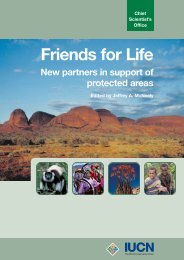Guidelines for Planning and Managing Mountain Protected Areas
Guidelines for Planning and Managing Mountain Protected Areas
Guidelines for Planning and Managing Mountain Protected Areas
- No tags were found...
Create successful ePaper yourself
Turn your PDF publications into a flip-book with our unique Google optimized e-Paper software.
<strong>Guidelines</strong> <strong>for</strong> <strong>Planning</strong> <strong>and</strong> <strong>Managing</strong> <strong>Mountain</strong> <strong>Protected</strong> <strong>Areas</strong>Because of their steepness, extreme weather conditions, <strong>and</strong> the instability of their soils,many mountain areas are marginal <strong>for</strong> commercial agriculture, though many support excellentsubsistence systems of farming, grazing <strong>and</strong> agro<strong>for</strong>estry. Most too are remote <strong>and</strong> inaccessible,so that mountain communities are far from markets, <strong>and</strong> the provision of services,such as education <strong>and</strong> health, <strong>for</strong> them is expensive. Most of the communities have also, untilrecently, been very self-contained. Globalization, with improved communications <strong>and</strong> access,may prove a mixed blessing; as well as bringing the benefits of better services <strong>and</strong> more directaccess to markets, they facilitate emigration <strong>and</strong> provide greater opportunities <strong>for</strong> people fromthe lowl<strong>and</strong>s to influence <strong>and</strong> exploit the resources <strong>and</strong> cultures of the mountains. Small farmsare disadvantaged as globalization is currently carried out.In many countries, the lowl<strong>and</strong> metropolitan centres have another conception of mountainareas. They are often viewed as supply areas, to be used or exploited <strong>for</strong> wood, water, wildlife,minerals, or recreational opportunity including mass tourism. Because they frequently <strong>for</strong>minternational borders, they are important <strong>for</strong> defence. The people who live there are often proud<strong>and</strong> independent, <strong>and</strong> considered unruly <strong>and</strong> backward by lowl<strong>and</strong>ers. The mountains are oftenendowed with valuable minerals; have <strong>for</strong>ests that can be exploited; they contain preferred sites<strong>for</strong> the impoundment of water <strong>for</strong> domestic <strong>and</strong> industrial use, <strong>for</strong> the generation of electricity<strong>and</strong> <strong>for</strong> irrigation. <strong>Mountain</strong>s can be developed <strong>for</strong> tourism, recreation <strong>and</strong> <strong>for</strong> second homes. Infact, they are looked upon both as an economic asset <strong>and</strong> as a liability or special responsibility.But their very remoteness <strong>and</strong> difficulty of access often means they are the last bastions of wild,untrammelled nature <strong>and</strong> unfettered evolutionary processes. This makes them rich treasuries ofnative biological diversity. It also means that they possess some of the last remaining largewilderness areas, <strong>for</strong> those who crave or need solitude <strong>and</strong> as much absence of hum<strong>and</strong>isturbance as possible.Since the earliest days of the establishment of protected areas, mountain areas have been afavourite choice. This has not always been <strong>for</strong> the best reasons. Many, it is true, have beenselected because of their special merits, but others largely because of their remoteness <strong>and</strong> thefact that they were of limited value <strong>for</strong> more lucrative economic activity. Moreover, selectionhas mainly been concerned with the protection of pristine l<strong>and</strong>scapes, natural ecosystems <strong>and</strong>magnificent scenery. In most instances, the way of life of any people who live in thesel<strong>and</strong>scapes has not been included in the criteria <strong>for</strong> selection, though this has witnesseddramatic improvement of late.<strong>Mountain</strong>s are indeed special places. Many of them have received legislative recognition bydesignation as parks or reserves of various kinds. It is <strong>for</strong> the planners <strong>and</strong> managers of thisestate <strong>and</strong> any future areas that the guidelines in this booklet are intended. They were<strong>for</strong>mulated <strong>for</strong> mountain protected areas (MtPAs) in the widest sense of both terms –“mountain” <strong>and</strong> “protected areas” (PAs).These are general guidelines or recommendations. Specific guidelines, it is hoped usingthese as a foundation, need to be developed at a national level <strong>and</strong> then at a PA level. At thislevel they should be much more specific, <strong>and</strong> should have local community input to meet thespecial needs <strong>and</strong> circumstances which prevail at any specific site. These guidelines are notpresented in any paternalistic way, but offered as a sharing of experience by 59 scientists <strong>and</strong>managers from 23 countries, assembled at South Africa’s Drakensbergs in a workshop in 2003.2






